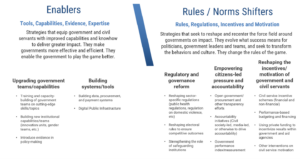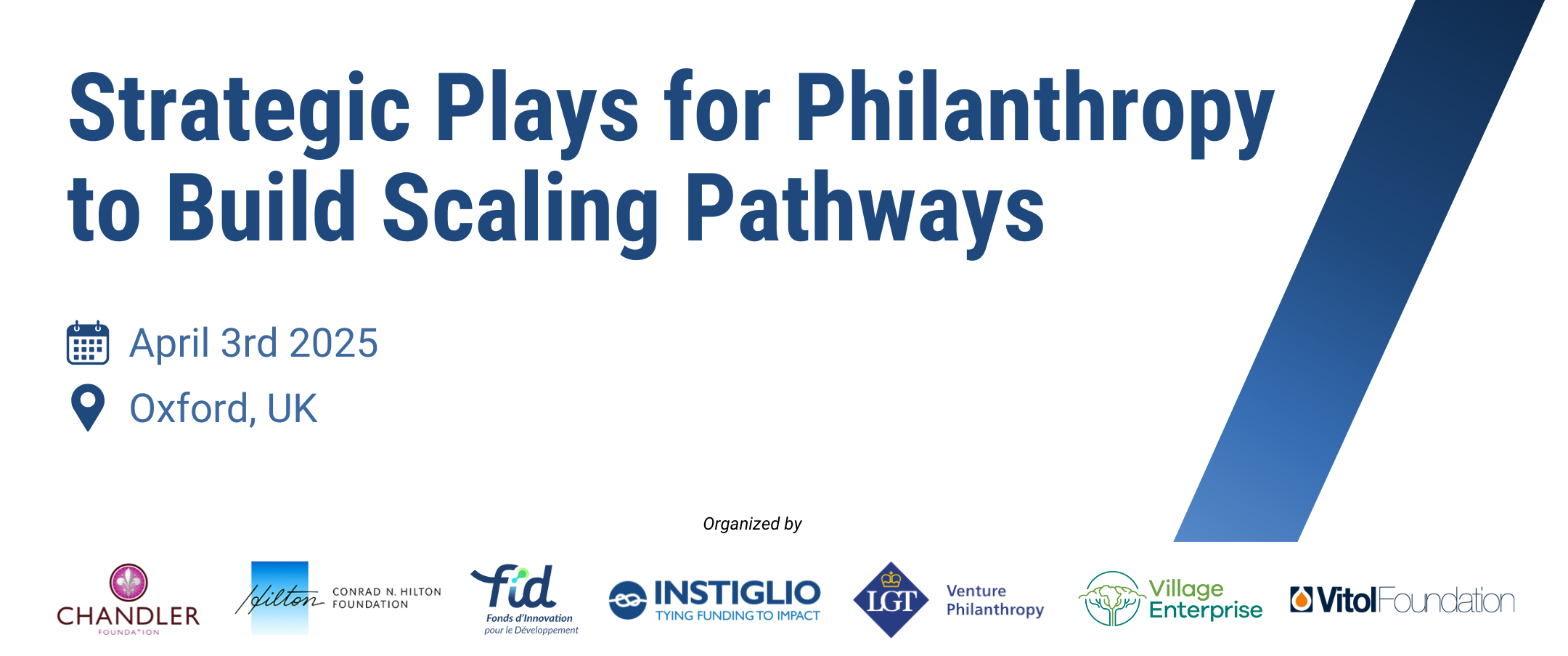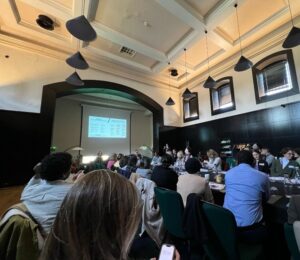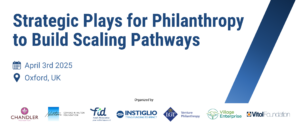
April 3rd, 2025 | Oxford, UK.
On April 3rd, 2025, sixty philanthropic leaders and development practitioners gathered in Oxford, on the sidelines of the 2025 Skoll World Forum, to explore practical strategies for maximizing impact in a changing aid landscape. Hosted by the Chandler Foundation, Conrad N. Hilton Foundation, the Fund for Innovation in Development at the French Agency for Development (FID-AFD), Instiglio, LGT Venture Philanthropy, Village Enterprise, and Vitol Foundation, the discussion centered on reimagining philanthropy’s role in supporting government-led transformation.
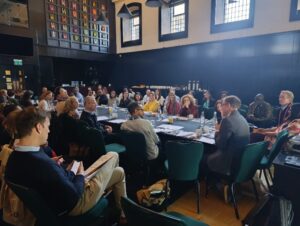
Three key takeaways emerged from the discussion:
– A call for philanthropy to refocus from primarily financing innovation and evidence to unlocking and strengthening government systems that can scale impact.
– A recognition of multiple pathways to elevate and leapfrog government systems, from open government to performance-based financing to digital transformation.
– A need to support government champions in creating more accountable systems with better governance, not just building technical capabilities.
1. Reimagining Philanthropy’s Role: From Funding Innovation to Enabling Government Systems
The fundamental challenge of scaling impact existed long before the current aid crisis. While philanthropy has successfully funded innovation and evidence-building, these proven solutions aren’t scaling to their potential. This theme resonated not just in this session but across the Skoll World Forum this year—a recognition that the field must pivot from primarily funding innovation to unlocking government systems as the sustainable, long-term partners for scaling impact.
“Today’s conversation is timely of course. As we look at rapidly shifting development aid resources, possibly with anywhere between 30-50% decrease by end of year, government leader in low/middle-income countries are clear that they need to adapt, to accelerate their systmes, elevate internal internal leadership, and build new capabilities to leapfrog the effectiveness with which they deploy resources. Philantorpy is uniquely positioned to support, leverage, and accelerate the important and hard reforms that government leaders need and want to drive to scale and sustain impact. ” — Avnish Gungadurdoss, Managing Partner at Instiglio (and facilitator for the session)
Ten years ago, the sector faced a deficit of innovation and evidence. Today, we have made strides in this field, but this is not translating into scaled impact. The changing aid landscape only amplifies the urgency for philanthropy to shift where it’s taking risks, from primarily funding innovation to actively unlocking the barriers to scaling impact through government systems. Philanthropy is uniquely positioned to play a catalytic role in this transformation, not by replacing government functions or continuing to fund parallel systems, but by strategically enabling governments to deliver at scale.
“Governments are the most important lever for determining social and economic outcomes of people. And yet, so many philanthropies and social impact organizations are doing work that isn’t necessarily supportive of that. Our observation at the Chandler Foundation is that we wanted to find tangible ways to support a national government that shared some of our priorities around good governance. We took what we now refer to as a government-first approach. Philantrophies can respond quickly to things and aren’t burdened by a very large institution that has a bureaucracy and certain rules. We can move quickly and nimbly.” — Tim Hanstad, Vice Chair, Chandler Foundation
“The vision was always to affect systems change at population scale level. Philanthropic funding allows us to catalyze solutions, allows us to innovate, allows us to create demonstration effects which government doesn’t necessarily have the capability, capacity, or risk appetite to do. Systems orchestration does not have quantitative impact metrics. It’s not easy to measure. It takes long. It’s complex. But with philanthropic funders, if they buy into that journey, that’s going to get you not incremental impact, but sizable, outsized impact when you get it right.” — Kasturi Soni, CEO, Harambee Youth Employment Accelerator
2. Multiple Strategic Pathways to Transform Government Systems
The discussion illuminated a range of ways for low and middle-income countries to chart their own path to effective governance, rather than replicating high-income country models. Speakers shared compelling approaches that philanthropy can support, all united by a focus on building locally-owned, sustainable systems.
Successful strategies included embedding performance incentives in government financing (as Instiglio demonstrated in Peru’s education system), creating multi-stakeholder frameworks for transparency and accountability (as the Chandler Foundation facilitated in Malawi), and thoughtfully transitioning from implementation to government integration (as Village Enterprise accomplished in Rwanda), among others.
“At Village Enterprise, we’ve been increasingly transferring our know-how to government so that they can enable us to scale as an organization. Starting with direct implementation allows governments to see your program in action. Having some direct implementation so that you can continue to innovate is also important, creating a lab that you can transfer to the government. As you’re transferring that know-how to governments, it’s really important to understand what is your secret sauce that makes you very effective and be very intentional about how you transfer that to a government.” — Caroline Bernadi, Head of Innovative Financing, Village Enterprise
The Fund for Innovation in Development (FID) highlighted the importance of context-specific approaches to embedding evidence in government decision-making, while Harambee demonstrated how an employment platform could evolve into a national system co-governed by public and private sectors.
Each of these approaches represents a different entry point in a broader strategic framework, but all share the fundamental goal of transforming how we deliver impact, moving beyond isolated programs to system-wide change.
“I’m really focused on thinking about how right now we live in a world where most governments are trapped thinking in terms of the silos of ministries. And the power and the capacity of digital technologies is its capacity for almost infinite scale and the reduction of marginal cost to almost zero in the way that it delivers things. Nigeria is never going to look like Canada institutionally. In the same way its telecommunications leapfrogged landlines to build a mobile-first network, its government will evolve differently—and that’s a good thing.” — David Eaves, Investment Committee of Co-develop, Associate Professor of Digital Government, University College London
3. Beyond Technical Capabilities: Strengthening Governance and Accountability
A recurring theme throughout the discussion was the need to not just build capabilities and tools but also create more accountable systems with better governance. This means supporting government champions in shifting the rules, incentives, and accountability structures that shape how systems operate.
“We didn’t design this for the ministry—we designed it with the ministry. And they came along at every step of the way. We co-designed frameworks with them, the methodology with them. And what that really did was allow the unit within the Ministry of Education to take this forward on their own. They were able to evolve the system over time to make sure that it still provides the right incentives, that it still focuses on the right bottlenecks. And they were able to integrate it into the legal and regulatory frameworks in the country. So, it was actually quite resilient, despite many political transitions. The real transformation happens when governments don’t just implement a system, but shape it, own it, and evolve it over time.” — Nicole Pflock, Associate Partner, Instiglio
Building constituencies for reform and local ownership emerged as critical success factors for sustainability beyond political cycles. This requires attention to both the enablers (capabilities, tools) and rule-shifters (governance reforms, incentives) in the framework shared with participants (see appendix).
What we’ve come to realize is that using evidence in governance isn’t just about producing data or running trials—it’s about understanding how evidence is absorbed in the real world. That means working within the complex, deeply human, and context-specific environments where decisions are made. It’s not a linear process. You have real people sitting around the table, each with their own incentives, pressures, and limitations. Embedding evidence into governance requires more than technical solutions—it takes relationships, trust, and systems that are flexible enough to adapt while still holding firm to the goal of long-term change.” – Amina Zahknouf, Investment Officer, FID-AFD
The most successful examples shared during the session demonstrated this dual approach—enhancing technical capacity while simultaneously reshaping the incentive structures and accountability mechanisms that ensure lasting change.
Moving Forward Together
The current aid landscape creates both urgency and opportunity to reimagine how philanthropy can support government-led transformation. By taking a more strategic approach to strengthening public systems, philanthropy can help unlock sustainable, locally led impact at unprecedented scale.
Participants called for continued collaboration, knowledge sharing, and joint action to develop and refine these approaches, ultimately creating a playbook that philanthropy can use to meet this pivotal moment.
The session concluded with the introduction of the Government Empowerment Network (GEN)—an initiative that Instiglio is developing in partnership with civil servants and government leaders, with support from the Hilton Foundation and Schmidt Futures, to directly address many of the challenges explored during the session.
For more information on this session, to participate in future convenings on this topic, or to learn more about the Government Empowerment Network (GEN), please contact Julia Loraque at partnerships@instiglio.org .
This event brought together 60 philanthropic leaders and development practitioners, representing organizations including the Gates Foundation, Cartier Philanthropy, Grand Challenges Canada, and many others. The strategic framework referenced in this document was shared during the session and is available in the appendix below.
Appendix:
